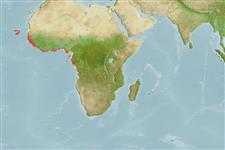Classification / Names
Common names from other countries
Main reference
Size / Weight / Age
Max length : 20.0 cm TL male/unsexed; (Ref. 57394); common length : 15.0 cm TL male/unsexed; (Ref. 2683)
Length at first maturity
Lm 38.8, range 7 - ? cm
Environment
Marine; brackish; benthopelagic; depth range ? - 60 m (Ref. 57394)
Climate / Range
Tropical, preferred 25°C (Ref. 107945); 18°N - 17°S, 29°W - 14°E
Distribution
Short description
Dorsal
spines
(total): 9;
Dorsal
soft rays
(total): 10;
Anal
spines: 3;
Anal
soft rays: 8. Diagnosis: body oblong and compressed; snout pointed, shorter than eye diameter; mouth strongly protrusible; nostrils contiguous, situated at midpoint between eye and snout tip; dorsal fin deeply notched; pectoral fins long, reaching to, or extending beyond anal-fin origin; large cycloid scales; scales of the interocular space not reaching anterior border of eyes; spinous part of dorsal fin greyish, without a black spot at tip (Ref. 57394).
Coloration: back olivaceous-brown, sides silvery, with longitudinal dark bands; young individuals with narrow, dark vertical bars on sides; spinous part of dorsal fin distally greyish, but without a distinct black spot at tip; juveniles with 2 longitudinal series of dark spots on dorsal fin (Ref. 57394).
IUCN Red List Status (Ref. 115185)
Threat to humans
Harmless
Human uses
Fisheries: commercial
More information
ReferencesAquacultureAquaculture profileStrainsGeneticsAllele frequenciesHeritabilityDiseasesProcessingMass conversion
Tools
Special reports
Download XML
Internet sources
Estimates of some properties based on models
Phylogenetic diversity index
PD50 = 0.5000 many relatives (e.g. carps) 0.5 - 2.0 few relatives (e.g. lungfishes)
Trophic Level
3.2 ±0.51 se; Based on food items.
Resilience
High, minimum population doubling time less than 15 months (Preliminary K or Fecundity.)
Vulnerability
Low vulnerability (16 of 100)
Price category
